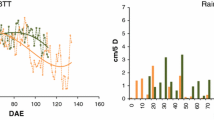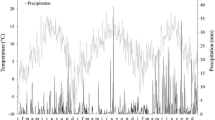Abstract
In organic farming, nitrogen efficiency of potato might vary among cultivars, even within the same maturity type. We therefore analysed in depth the response to nitrogen of a diverse set of cultivars, grown at different locations (differing in soil type and management) and in four years (differing in temperature and rainfall patterns). Yield increased with an increase in nitrogen supply and with growing later cultivars if the crop cycle lasted long enough. When crops had to be flamed to prevent spread of late blight, late cultivars yielded less than early cultivars, especially under high nitrogen. By measuring the fraction of soil covered by green leaves throughout the growing season and using a model, we analysed canopy development in detail and related nitrogen and genotype sensitive model parameters to tuber yield. In one year with early, temporary drought, model prediction was poor. We observed that cultivars that rapidly established a high maximum soil cover, maintained that maximum for long and senesced slowly, could sustain high yields. When late-blight infection was late, these (mid)-late cultivars showed high agronomic nitrogen use efficiency, but were not (always) high in nitrogen uptake efficiency, accumulation of nitrogen in the tubers or nitrogen utilisation efficiency. When late-blight infection started early, early or mid-late cultivars that rapidly established a high maximum soil cover under low nitrogen availability gave best performance. In most years, early canopy development is responsive to nitrogen, shows genetic variation, and is significantly related to early tuber yield. Nitrogen-efficient cultivars suitable for organic production should have rapid early canopy development, a high agronomic nitrogen use efficiency and nitrogen utilisation efficiency, but a low nitrogen concentration in the tubers.


Similar content being viewed by others

References
Bangemann L-W, Sieling K, Kage H (2014) The effect of nitrogen and late blight on crop growth, solar radiation interception and yield of two potato cultivars. Field Crops Res 155:56–66
Biemond H, Vos J (1992) Effects of nitrogen on the development and growth of the potato plant. The partitioning of dry matter, nitrogen and nitrate. Ann Bot 70:37–45
Bock BR (1984) Efficient use of nitrogen in cropping systems. In: Hauck RD (ed) Nitrogen in crop production. American Society of Agronomy, Madison, WI, pp 273–294
Bucher M, Kossmann J (2007) Molecular physiology of the mineral nutrition of the potato. In: Vreugdehil D (ed) Potato biology and biotechnology, advances and perspectives. Elsevier, Amsterdam, pp 311–329
Errebhi M, Rosen CJ, Gupta CG, Birong DE (1998) Potato yield response and nitrate leaching as influenced by nitrogen management. Agron J 90:10–15
Ewing EE, Struik PC (1992) Tuber formation in potato: induction, initiation, and growth. Hort Rev 14:89–198
Finckh MR, Schulte-Gelderman E, Bruns C (2006) Challenges to organic potato farming: disease and nutrient management. Potato Res 49:27–42
Haverkort AJ, MacKerron DKL (eds) (2000) Management of nitrogen and water in potato production. Wageningen Press, Wageningen
Hoofdproductschap Akkerbouw, sector Aardappelen (HPA) (2003) Ontheffingenbeleid bestrijding Phytophthora infestans 2003. N021361a.BK
Khan MS, van Eck HJ, Struik PC (2013) Model-based evaluation of maturity type of potato using a diverse set of standard cultivars and a segregating diploid population. Potato Res 56(2):127–146
Lammerts van Bueren ET, Tiemens-Hulscher M, Struik PC (2008) Cisgenesis does not solve the late blight problem of organic potato production: alternative breeding strategies. Potato Res 51(1):89–99
Möller K, Habermeyer J, Zinkernagel V, Reents H (2007) Impact and interaction of nitrogen and Phytophthora infestans as yield-limiting and yield-reducing factors in organic potato (Solanum tuberosum L.) crops. Potato Res 49:281–301
Neeteson JJ, Wadman WP (1987) Assessment of economically optimum application rates of fertilizer N on the basis of response curves. Fertil Res 12:37–52
Van Delden A (2001) Yield and growth of potato and wheat under organic N-management. Agron J 93:1370–1385
Van der Burgt GJHM, Oomen GJM, Habets ASJ, Rossing WAH (2006) The NDICEA model, a tool to improve nitrogen use efficiency in cropping systems. Nutr Cycl Agroecosyst 74:275–294
Van Kempen P, le Corre P, Bedin P (1996) Phytotechnic. In: Rousselle P, Crosnier RY (eds) La pomme de terre. INRA, Paris, pp 363–414
Vos J (1995) Foliar development of the potato plant and modulations by environmental factors. In: Kabat P, Marshall B, van den Broek BJ, Vos J, van Keulen H (eds) Modelling and parameterization of the soil–plant–atmosphere system. Wageningen Pers, Wageningen, pp 21–38
Vos J (1997) The nitrogen response of potato (Solanum tuberosum L.) in the field: nitrogen uptake and yield, harvest index and nitrogen concentration. Potato Res 40:237–248
Vos J (2009) Nitrogen responses and nitrogen management in potato. Potato Res 52(4):305–317
Vos J, Biemond H (1992) Effects of nitrogen on the development and growth of the potato plant. 1. Leaf appearance, expansion growth, life spans of leaves and stem branching. Ann Bot 70:27–35
Vos J, MacKerron DKL (2000) Basic concepts of the management and supply of nitrogen and water in potato production. In: Haverkort AJ, MacKerron DKL (eds) Management of nitrogen and water in potato production. Wageningen Pers, Wageningen, pp 15–33
Yin X, Kropff MJ, McLaren G, Visperas RM (1995) A nonlinear model for crop development as a function of temperature. Agric Forest Meteorol 77:1–16
Zebarth BJ, Tai G, Tarn R, de Jong H, Milburn PH (2004) Nitrogen use efficiency characteristics of commercial potato cultivars. Can J Plant Sci 84(2):589–598
Acknowledgments
This project was financially supported by the Dutch Ministry of Economic Affairs under the Research Programme Bioconnect for Organic Plant Breeding from 2008 to 2011. We are grateful for the valuable contribution from the supervising committee to the discussions on the results during the project years.
Author information
Authors and Affiliations
Corresponding author
Rights and permissions
About this article
Cite this article
Tiemens-Hulscher, M., Lammerts van Bueren, E.T. & Struik, P.C. Identifying nitrogen-efficient potato cultivars for organic farming. Euphytica 199, 137–154 (2014). https://doi.org/10.1007/s10681-014-1143-z
Received:
Accepted:
Published:
Issue Date:
DOI: https://doi.org/10.1007/s10681-014-1143-z



